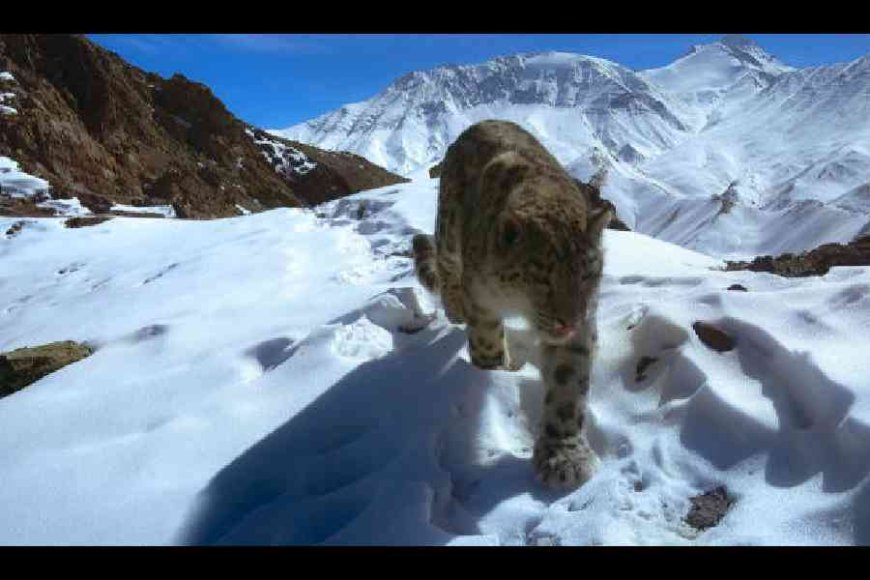Earthsounds: Unveiling Nature's Sonic Symphony
Journeying Through the Unseen World of Animal Communication

Nature is resonating with auditory teachings that we often ignore, such as the snow leopards' mating cry or the noises that bind inquisitive meerkats. Animal noises, whether they are mating displays or territorial battles, have a lot to say. The creators of the upcoming series Earthsounds on Apple TV+ have spent years crafting an engaging experience that transports viewers to ice shelves, coral reefs, rainforests, and other amazing places. It unveils a world teeming with seldom-heard aural tales that are surprising, strange, and unheard.
A mysterious love ballad
Producer Sam Hodgson, executive producers Alex Williamson and Isla Robertson, and director Tom Hiddleston keep everything together. A two-minute clip of, say, howler monkeys trying to outscream at each other can seem "simple" on TV, but it might have taken the team weeks or months to record. It makes sense why it took almost four years to finish the program. The epidemic was also a hindrance.
"We started producing in December of 2019." Thus, it took almost four years to complete. We had a little period of time to organize those shoots and figure out precisely the story we wanted to convey on this one since we had already started shooting when Covid struck. spanning a video chat, Alex said, "There was a lead-up period and then, for example, the snow leopards... that was a filming period over sort of two years."
throughout order to conduct acoustic study on Puerto Rican parrots, Bourhan Yassin installed microphones throughout the island's jungles.
throughout order to conduct acoustic study on Puerto Rican parrots, Bourhan Yassin installed microphones throughout the island's jungles.
In order to capture footage of the snow leopards, the Earthsounds team set up camera traps in the highlands and left them there for two years, working with some very talented Indian camera operators. "As you might guess, snow leopards are very challenging creatures to film and observe. Our goal was to record the snow leopard's even more difficult love song. After two years of leaving the camera traps in place, we were actually back in the UK during the editing process when we eventually received word that one of the snow leopards had approached the trap, kind of broadcasting his love song, and that we had managed to get the purest and closest recording of a snow leopard ever. There are twelve episodes with a wide variety of tales, and it was only one narrative in one. Sam said, "We had numerous shoots going on all across the globe at the same time, capturing the noises and the behavior.
Not to mention almost 3,000 hours of audio captured from the natural environment to create six hours of television, we're talking about several shoots spread over 20 nations.
"What was cool is that sound recorders are often the unsung heroes of television, receiving all the credit while camera operators get all the attention." It was wonderful to see the sound recordist given a chance to flourish in this production. With all of their many gadgets, they can become really geeky, and we have microphones everywhere. Along with developing new technology, we also created whole new kinds of microphones. We created and constructed remote cameras with such microphones inside of them to film the snow leopards.
original solutions
Every narrative has a different kind of microphone. Hydrophones were necessary for the spinner dolphin. However, you will hear the sound of the water hitting the boat if you attempt to capture the noises of dolphins off the side of the vessel.
Therefore, we created a buoy system that would allow you to float these hydrophones across the water. And the dolphins never went anywhere near it for four, five, or six days. I believe they were intrigued on the seventh day, when this pod of dolphins passed directly in front of the microphone. This incredible sound came from inside a pod of dolphins. However, there was also an ultrasonic component to the mics. In order for it to capture noises that are above the range of human hearing. Upon returning the sounds to the UK, we examined a spectrogram and were able to see every sound. The pair said, "I believe this is what makes the series so fantastic.
Earthsounds: The key of humpback whales' ability to capture fish using sound is revealed by little "onboard" microphones on the animals.
Earthsounds: The key of humpback whales' ability to capture fish using sound is revealed by little "onboard" microphones on the animals.
They reduced all of that sound to a level that is audible to humans using a process known as pitch shifting. "And then we noticed that the dolphins were swimming around and we had never heard anything like this before—all these lovely, eerie whistles and clips."
Infrasonic microphones were also used to capture elephant noises, which are beyond human hearing. "The elephants are communicating across deserts about where water is by means of these incredible, eerie whispers that can be heard across an area of 100 square miles. And we've never heard anything like it on TV before.
Furthermore, we are discussing noises that we were unaware ever existed. "We captured termite footsteps on record, and we found that their noise level is 100 times lower than that of an ant's." Thus, it's most likely among the most subtle noises found in the natural world. We have a tale about foxes with enormous ears known as "bat-eared foxes." They have the capacity to detect minute noises. That was also captured on tape.
Other methods were also used, such as temporal stretching, which enables us to reduce sound speed. The sound usually goes quite deep as you slow it down, or the tone will change if you do it on your phone. For the first time, sound may now be slowed down without affecting its frequency or pitch. We can now hear noises that are too quick for the human ear to detect because to this. We recorded the Australian lyrebird with it. Their extraordinarily intricate cries may resemble nearly 20 distinct species of birds. We could also hear that there are two elements—high notes and lower notes—that sang simultaneously when we slowed it down.
Soundscape scientist Bernie Krause recorded an audio tour of California's Sugarloaf Ridge State Park for Earthsounds.
Soundscape scientist Bernie Krause recorded an audio tour of California's Sugarloaf Ridge State Park for Earthsounds.
Naturally, they also saw how the fauna was changing. We collaborated with Bernie Krause, a renowned sound recordist who resides in California. For almost thirty years, Bernie has been visiting the same location at Sugarloaf Ridge, a nearby state park, and he has been recording there every year at the same time on the same day. Additionally, he has been observing the variations in the noises.
Earthsounds visits amazing environments, such as the tropical coral reefs, Antarctic ice shelf, Namibian dunes, and Queensland rainforest, among others. However, strange noises are not limited to animal sounds. The series also catches the eerie buzz of the northern lights and the hum of drinking trees and deserts, among other hidden noises of our earth.
Except for the headline, this story has not been edited by Press Time staff and has been published from a syndicated feed.























































